The global breast imaging market is estimated to be valued at USD 4.82 Bn in 2025 and is expected to reach USD 8.32 Bn by 2032, exhibiting a compound annual growth rate (CAGR) of 8.1% from 2025 to 2032.
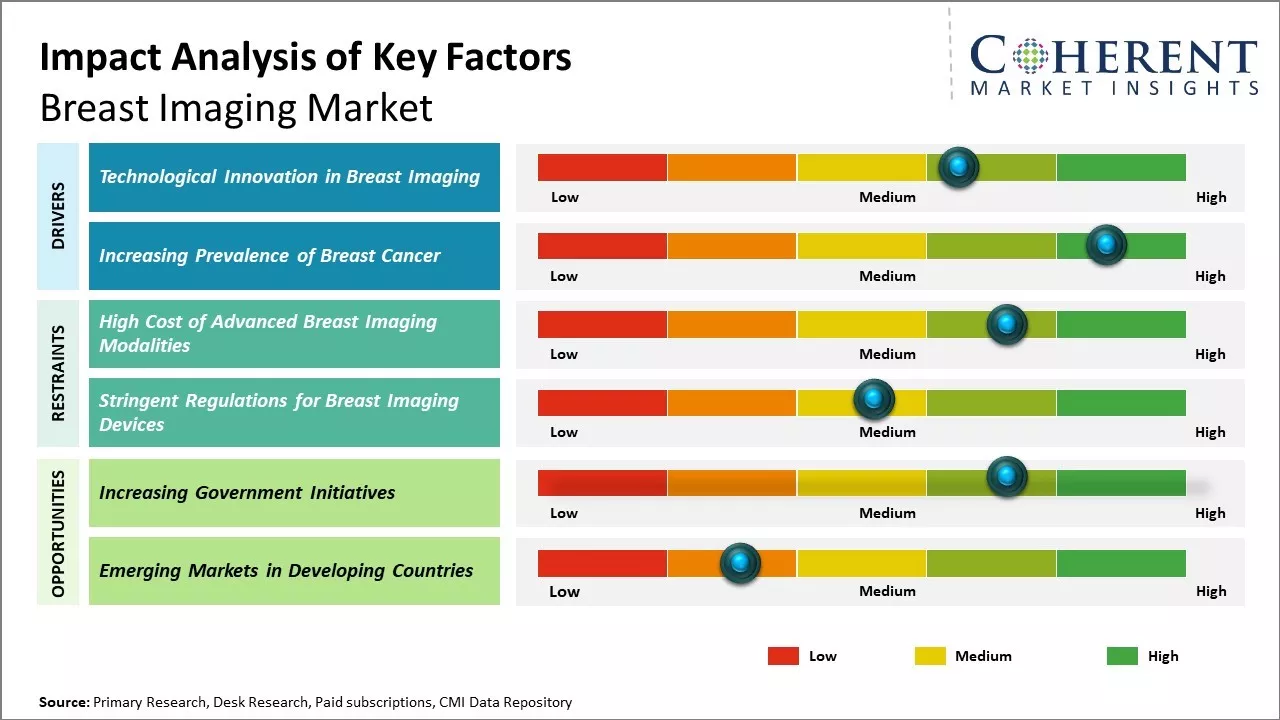
Discover market dynamics shaping the industry: Download Free Sample
Significant growth in the women population worldwide along with rising awareness about early breast cancer detection is expected to drive the demand for advanced breast imaging modalities. Further, ongoing technological advancements in breast imaging equipment focused towards improved patient diagnosis and care will support the breast imaging market expansion through 2032. Growing healthcare expenditure across developing nations will further aid the increased adoption of digital mammography and other breast imaging devices. However, high costs associated with digital breast imaging systems and procedures could challenge market growth to some extent over the coming years.
Technological Innovation in Breast Imaging
Mammography is one of the prominent innovations in breast imaging. It is a screening technology that helps decrease the breast cancer mortality rate. Thus, healthcare providers are stepping up to produce screening modalities and products that will help provide better imaging and detect cancer that may replace traditional mammography. Artificial intelligence (AI) is one the most interesting areas of advancement for improving cancer detection and workflow. AI is poised to bring about the next era of groundbreaking advancements in mammography. Moreover, 3-D mammography is a newer breast imagining modality. 3-D mammography helps to improve the performance of mammography in both fatty and dense breasts. For instance, Hologic 3-D mammography, a combined examination of 3-D and 2-D imaging, helps enhance the quality of cancer detection.
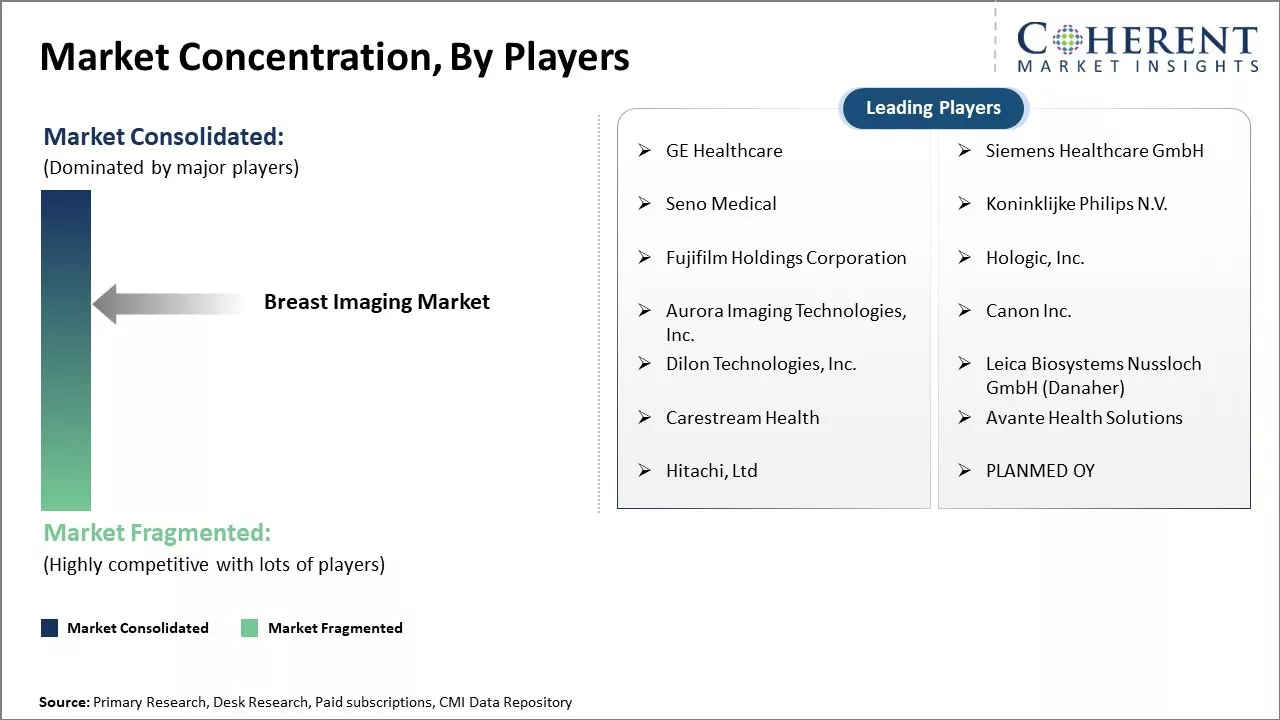
Get actionable strategies to beat competition: Download Free Sample
Increasing Prevalence of Breast CancerBreast cancer is the most common types of malignancy in women, and one of the three most common cancers worldwide. Spread of breast cancer has become one of the major health challenges in human society. A number of breast cancer screening methods are available in the market. Early detection of breast cancer at initial stage helps to improve survival rate in patients. Thus, the increasing prevalence of breast cancer is likely augmenting the imaging equipment’s. For instance, according to the American Cancer Society's estimates, approximately 287,850 new cases of invasive breast cancer were diagnosed in women in 2022.
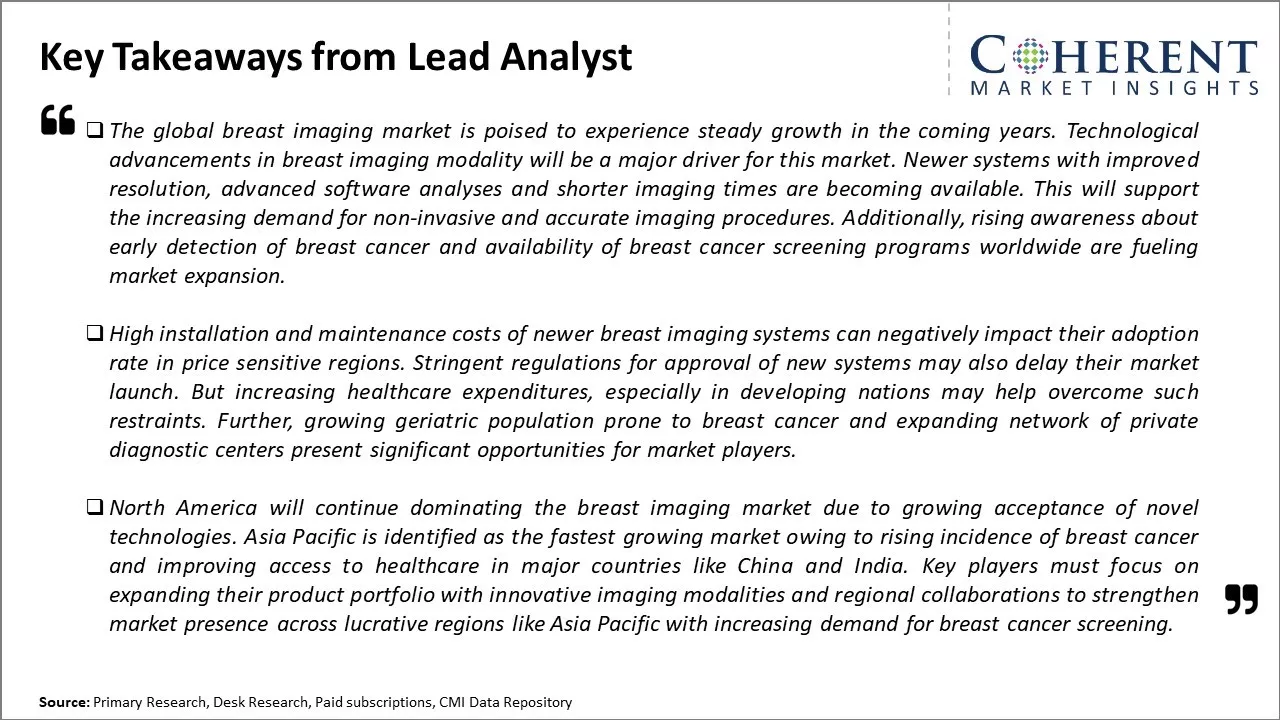
To learn more about this report, Download Free Sample
Market Challenges – Stringent Regulations for Breast Imaging DevicesStringent regulations for breast imaging devices by regulatory authorities are posing a challenge for the growth of global breast imaging market. Various regions and countries have implemented strict guidelines and quality standards to ensure patient safety while using medical imaging equipment for breast screening and diagnosis. Complying with these regulations involve lengthy product approval process, high certification costs, and adhering to quality control protocols during manufacturing.
Market Opportunities – Increasing Government Initiatives
Increasing adoption of inorganic growth strategies, such as government initiatives, is expected to drive growth of the global breast imaging market. For instance, in March 2021, the World Health Organization (WHO), in collaboration with the International Agency for Research on Cancer (IARC) and the International Atomic Energy Agency (IAEA), launched the Global Breast Cancer Initiative. The Global Breast Cancer Initiative will focus on efforts on the potential of multi-sectoral partnerships, programmes that promote sustainable capacity-building, and innovation and monitoring systems that use data for decision-making.
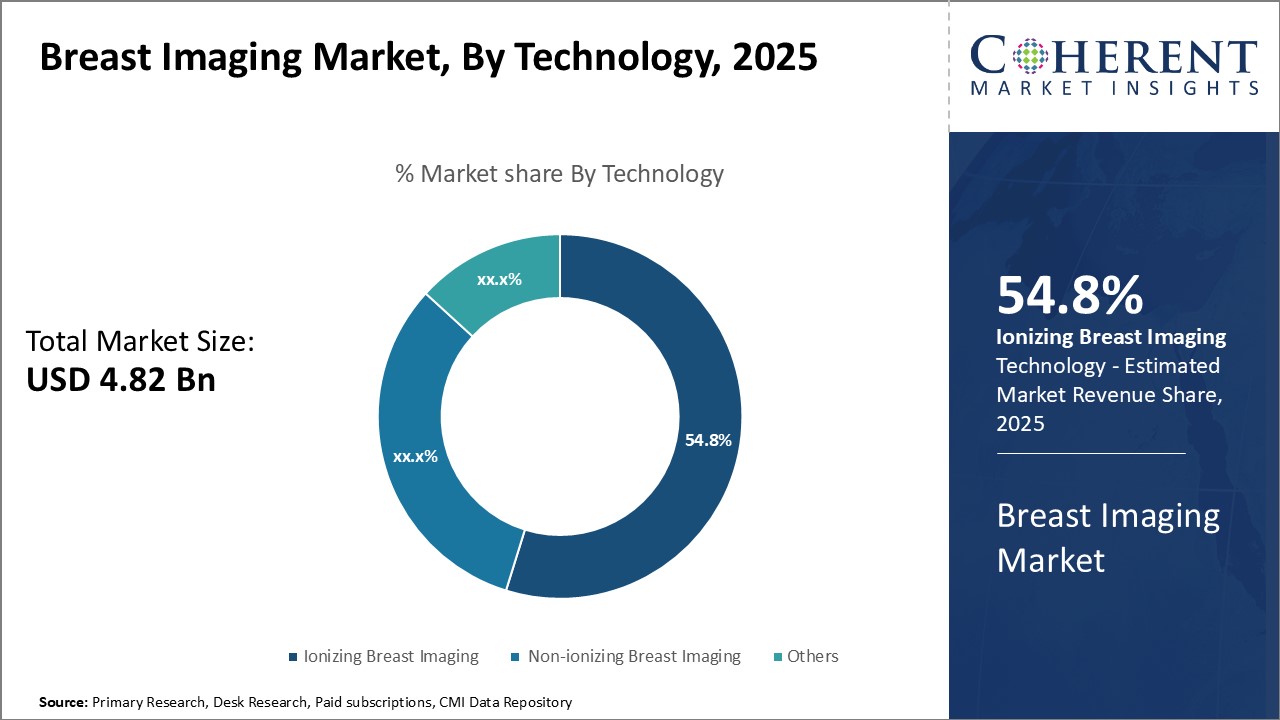
Discover high revenue pocket segments and roadmap to it: Download Free Sample
Insights, By Technology: Widespread Adoption and Clinical EfficacyThe technology segment includes ionizing breast imaging, non-ionizing breast imaging, and others. The ionizing breast imaging sub-segment is estimated to hold 54.8% of the market share in 2025 due to its immunological compatibility advantages over autologous therapies. Allogeneic cell therapy involves the use of donor cells that are not genetically identical to the recipient. This overcomes many limitations of autologous cell therapies, which use a patient's own cells. With allogeneic cell therapies, large batches of unmodified donor cells can be mass produced in advance and stored for immediate off-the-shelf use by multiple patients. This efficient production process and immediacy of treatment provides significant advantages over customized autologous therapies.
Insights, By End User: Central Role of Hospitals in Cancer Screening Programs and Diagnostic Workflows
The end user segment includes hospitals, diagnostic centers, and others (specialty clinics, ambulatory surgical centers, etc.). The hospitals sub-segment is estimated to hold 32% of the market share in 2025. National breast cancer screening programs predominantly utilize digital mammography facilities located within hospitals or affiliated outpatient imaging centers. This is due to hospitals' extensive radiology infrastructure, qualified technologists and radiologists, and seamless connectivity to biopsy and oncology services should abnormalities be detected. Hospitals also facilitate complex diagnostic evaluations. Women with suspicious findings on mammograms or concerning breast signs/symptoms are usually referred to hospitals for additional imaging exams like breast ultrasonography or Magnetic Resonance Imaging. These advanced modalities require specialized technicians and equipment only found in hospital radiology departments. Hospitals then centrally coordinate follow-up tissue sampling like needle biopsies and link patients to surgical oncology care if cancer is diagnosed.
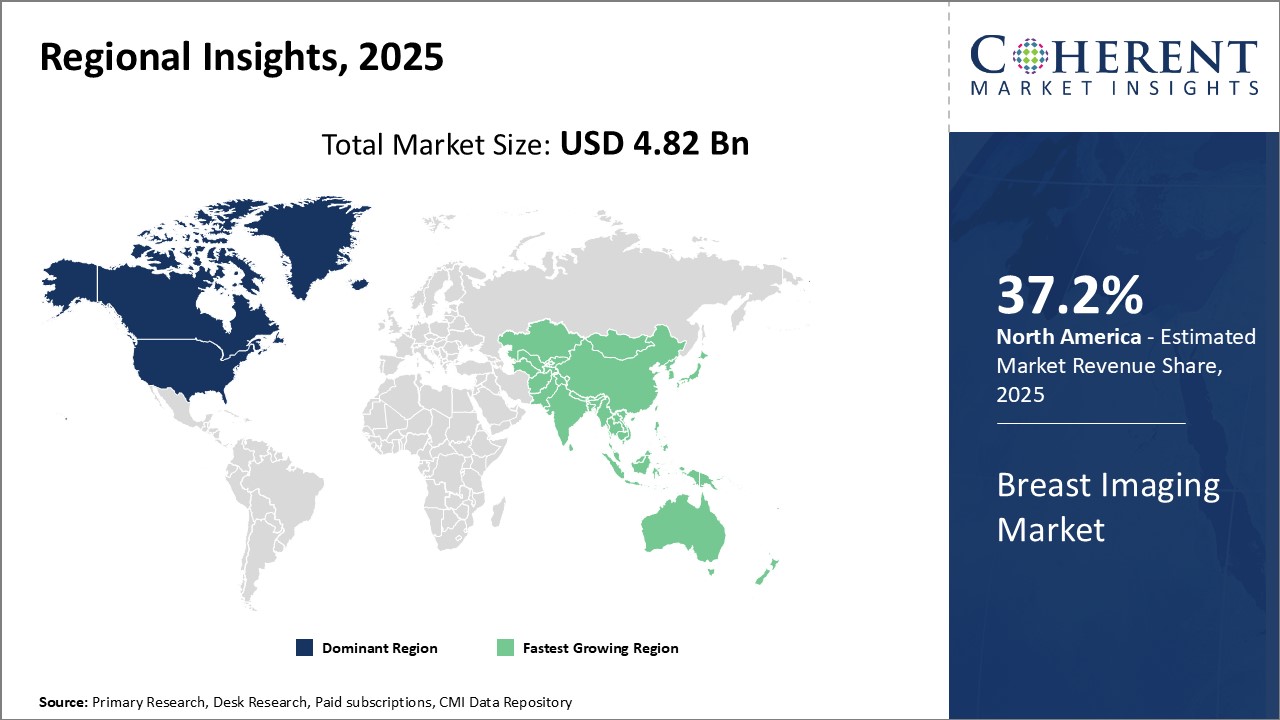
Need a Different Region or Segment? Download Free Sample
North America remains the dominant region in the global metabolic testing market and is estimated to hold 37.2% of the market share in 2025. North America is home to several leading original equipment manufacturers (OEMs) and has a strong presence of industry heavyweights such as GE Healthcare and Hologic. Breast cancer screening programs along with access to advanced diagnostic technologies have boosted demand in this region. Moreover, strong partnering between market players and research institutions have facilitated rapid technology upgrades. For instance, many OEMs collaborate with hospitals and clinics to continually enhance their product offerings. Rising public awareness about breast cancer prevention through screening is positively influencing the regional market.
The Asia Pacific region has emerged as the fastest growing market for breast imaging globally. Countries like China, Japan, and India are expected to significantly drive the regional market growth during the forecast period. Rapid economic development, growing healthcare infrastructure, and rise in per capita income have collectively augmented the ability of hospitals and diagnostic centers to invest in premium imaging technologies. Additionally, the region is witnessing a sharp increase in breast cancer cases primarily due to lifestyle changes, urbanization, and rapidly aging population. This has intensified the need for early cancer detection and better care facilities. Further, several global organizations are focusing on creating breast healthcare awareness programs across developing economies which will bolster regional market prospects.
Breast Imaging Market Report Coverage
| Report Coverage | Details | ||
|---|---|---|---|
| Base Year: | 2024 | Market Size in 2025: | USD 4.82 Bn |
| Historical Data for: | 2020 To 2024 | Forecast Period: | 2025 To 2032 |
| Forecast Period 2025 to 2032 CAGR: | 8.1% | 2032 Value Projection: | USD 8.32 Bn |
| Geographies covered: |
|
||
| Segments covered: |
|
||
| Companies covered: |
GE Healthcare, Siemens Healthcare GmbH, Seno Medical, Koninklijke Philips N.V., Fujifilm Holdings Corporation, Hologic, Inc., Aurora Imaging Technologies, Inc., Canon Inc., Dilon Technologies, Inc., Leica Biosystems Nussloch GmbH (Danaher), Carestream Health, Avante Health Solutions, Hitachi, Ltd, and PLANMED OY |
||
| Growth Drivers: |
|
||
| Restraints & Challenges: |
|
||
Uncover macros and micros vetted on 75+ parameters: Get instant access to report
*Definition: Breast cancer is one of the leading causes of death in women. Breast imaging is a technique that involves imaging of the breast for screening or diagnostic purposes. Breast imaging can be done with digital mammography, digital breast tomosynthesis (3-D Mammography), breast ultrasound, breast MRI, and among others. Among these, mammography is the most common methods of breast imaging.
Share
Share
About Author
Manisha Vibhute is a consultant with over 5 years of experience in market research and consulting. With a strong understanding of market dynamics, Manisha assists clients in developing effective market access strategies. She helps medical device companies navigate pricing, reimbursement, and regulatory pathways to ensure successful product launches.
Missing comfort of reading report in your local language? Find your preferred language :
Transform your Strategy with Exclusive Trending Reports :
Frequently Asked Questions
Joining thousands of companies around the world committed to making the Excellent Business Solutions.
View All Our Clients